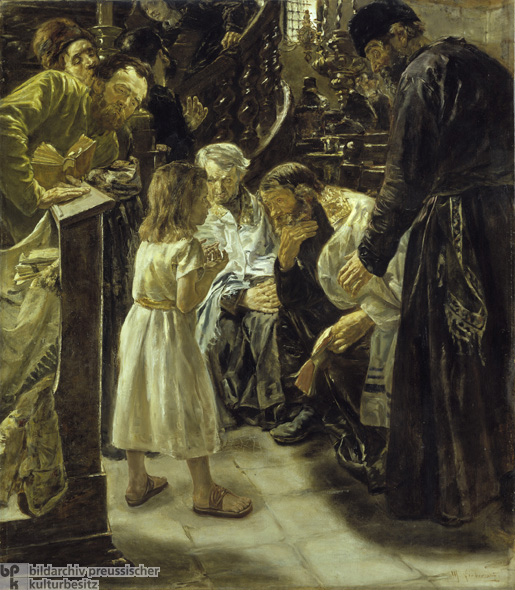|
Max Liebermann, The Twelve-Year-Old Jesus in the Temple [Der zwölfjährige Jesus im Tempel] (1879)
In its original form, this painting by Max Liebermann (1847-1935) produced the greatest art scandal of the Bismarckian era. The trouble began during Munich’s First International Art Exhibition in 1879 – that is, when a wave of antisemitic agitation and propaganda was just beginning to break over Germany. The art critic for the Augsburger Allgemeine Zeitung, Friedrich Pecht, declared that Liebermann had painted “the ugliest, know-it-all Jewish boy imaginable,” adding that the artist had shown the Jewish elders as “a rabble of the filthiest haggling Jews.” German feelings, Pecht believed – and others concurred – had been offended by this blasphemous painting. Not long thereafter, Pecht’s critique was cited in debates in the Bavarian state parliament, where one deputy declared that Liebermann [himself a Jew] should have known better than to paint this scene; and the painting was reviled as a stench in the nostrils of decent people. That Liebermann was not only a Jew but also a Prussian liberal did not sit well either. The antisemitic leader of the Christian Social Party, Court Preacher Adolf Stöcker, directed a hail of invective against the artist, whose nationalist credentials were not enhanced in 1881 when he became the first German artist since the Franco-Prussian War of 1870-71 to receive an award from a great salon of Paris. Liebermann’s painting, which quickly became a cause célèbre, pitted antisemites and traditionalists against other progressive painters of the day, including Wilhelm Leibl, Franz von Lenbach, and Fritz von Uhde (the latter bought and kept the painting until 1911). If Friedrich Pecht’s description of Liebermann’s Jesus seems ill-suited to the long-haired, slightly effeminate, blond boy featured in the present canvas, then this is because Liebermann, in response to critical outcry, repainted the figure before it was included in a Paris exhibition in 1884. Fortunately, a sketch of the untouched 1879 version has been preserved, so we know that Liebermann had originally depicted a barefoot boy with short, unkempt dark hair and a stereotypical Jewish profile. In the sketch, the boy gestures assertively and assumes a provocative stance as he argues with the Jewish elders. In the reworked version, shown here, Liebermann changed the young Jesus’s appearance. The figure once described as an “urchin” now appears as a serious, intelligent – perhaps slightly deferential – child. Nevertheless, this dramatic change won over virtually none of Liebermann’s earlier critics. The painting was not exhibited again until the Berlin Secession exhibition of 1907. (For the source of the above quotations, please see: Beth Irwin Lewis, Art for All? The Collision of Modern Art and the Public in Late-Nineteenth-Century Germany. Princeton: Princeton University Press, 2003, pp. 46-51.)

|


